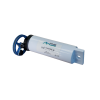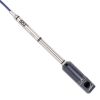PME miniDOT Dissolved Oxygen Logger
Features
- Long-lasting sensor with stable calibration
- Up to 1-year battery life with user-replaceable batteries
- Also records time, date, and battery voltage
- Expedited repair and warranty service
- Lifetime technical support
- More
Overview
The PME miniDOT is a submersible instrument that includes an optical dissolved oxygen sensor, a temperature sensor, batteries and a micro SD memory card. Data is recorded internally with a sample interval from once per minute to once per hour and can be offloaded to a computer via USB cable.
Internal Storage
The miniDOT sensor is an optode that measures lifetime-based luminescence quenching of a thin membrane. The sensing foil contains a coating with a variable fluorescence that depends on oxygen concentration in the surrounding water. The sensor can compute dissolved oxygen concentration in mg/L and record these measurements internally. Each logger is factory-calibrated at 12 dissolved oxygen concentrations, each at 8 temperatures, for a total of 96 calibration points.
Included with miniDOT logger (Part #7450):
- miniDOT dissolved oxygen logger
Included with miniDOT logger with wiper bundle (Part #9190):
- miniDOT dissolved oxygen logger
- miniWIPER anti-fouling sensor wiper
- miniWIPER bracket
- anti-fouling copper plate (with hardware)
In The News
Thin Ice: Year-Long Monitoring in Missouri Reservoirs
The value of multi-lake studies is well understood by international organizations like the Global Lake Ecological Observatory Network (GLEON) and the scientists who work tirelessly to provide data to the larger network. Rebecca North, an associate professor at the University of Missouri-Columbia , is one of many researchers involved in multi-lake research initiatives and conducting research locally in her home state. Having been born and raised on the shore of Lake Ontario, North grew up in a community that revolved around water. She also saw firsthand one of the worst water quality bodies of the world, the Bay of Quinte, decline throughout her lifetime.
Read MorePME miniDOT Logger: Plunge into Data
The PME miniDOT Logger is a compact data logger that measures dissolved oxygen (DO) and temperature down to 100 meters in depth. The unit can also endure low water temperatures and is durable underneath an ice layer, which is excellent for gathering essential winter water quality data that is lacking from using less robust equipment. The high depth rating and ability to withstand frigid temperatures make the PME a reliable device that is deployable in dramatically different environments, such as a monitoring well, an inland lake or an underwater cave. The logger itself features an optical DO sensor, temperature sensor, two AA lithium batteries and a micro SD memory card.
Read MoreData-Driven Advocacy on the Lower Deschutes River
Like many freshwater environments, the Deschutes River in Oregon is under pressure from development, pollution, and climate change. Many rivers, streams and lakes in the Deschutes Basin do not meet Oregon water quality standards –where state water quality monitoring assesses levels of bacteria, pH, dissolved oxygen, temperature, and fine sediment. Hannah Camel is the Water Quality Coordinator for the Deschutes River Alliance (DRA), a non-profit organization that focuses on the health of the lower 100 miles of the Deschutes River–the area most affected by human intervention. As a data-driven organization, the DRA has benefited from the installation of two NexSens X2 data loggers.
Read More


















